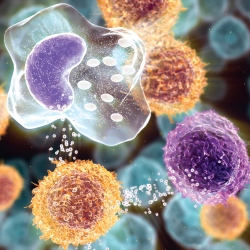
Using a newly discovered cell technology, Georgetown University Medical Center researchers were able to identify an effective therapy for a patient with a rare type of lung tumor. The single case study provides a snapshot of the new technology’s promising potential, but the researchers caution that it could be years before validation studies are completed and regulatory approval is received for its broader use.
The patient in the case study was a 24-year-old man with a 20 year history of HPV-positive recurrent respiratory papillomatosis (RRP). RRP is the most common benign neoplasm of the larynx usually due to infection by HPV that is acquired at birth during passage through an HPV-infected birth canal. The standard treatment is surgical removal of the tumors to clear the airway.
The patient has had 350 such surgeries and has received chemotherapy for much of his life. In rare instances (three to five percent of cases), RRP can extend below the vocal cords. This patient’s clinical course is even more uncommon because it spread into his lungs, a stage which occurs in less than one percent of people infected. There are no effective treatments for this disease stage, which is almost invariably fatal.
“Early on, we recognized this highly unusual case as one that would allow us to try the new technique with the added bonus of potentially helping the patient,” explains the study’s senior investigator, Richard Schlegel, M.D., Ph.D.,chairman of the Department of Pathology at Georgetown Lombardi Comprehensive Cancer Center, a part of Georgetown University Medical Center.
Keeping tumor cells alive to test treatmentsThe technology used is one that keeps normal and tumor cells alive indefinitely in the laboratory — which previously had not been possible. In this case, the technique allowed researchers to establish live cultures of the patient’s normal and tumor cells (with the patient’s consent) so that treatments could be screened for in vitro activity.
